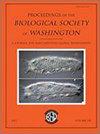A new species of the genus Nannopus (Copepoda, Harpacticoida, Nannopodidae) from the mudflat of Ganghwa Island, Korea
IF 0.5
4区 生物学
Q3 Agricultural and Biological Sciences
Proceedings of the Biological Society of Washington
Pub Date : 2016-12-01
DOI:10.2988/0006-324X-129.Q3.212
引用次数: 4
Abstract
Abstract During a study of the harpacticoid copepods from the intertidal mudflat of Ganghwa Island, in the Yellow Sea of Korea, a new species of the genus Nannopus was discovered. Nannopus ganghwaensis shared the character of seven elements in P4 exp-3 with N. flexibilis Lilljeborg, 1902, N. didelphis Fiers & Kotwicki, 2013, and N. hirsutus Fiers & Kotwicki, 2013. However, the new species was clearly distinguished from the three congeners by the combination of the following character states: (1) absence of the integumental window on the dorsal surface of cephalothorax, (2) the lateral margins of urosomites is not densely hirsute, (3) the distal small seta of P4 endopod is naked, (4) the innermost seta of P5 exopod fused to the segment, (5) the inner most distal seta of P2 enp-2 is 1.7 times longer than the outer spine of its segment, and (6) caudal seta IV slightly inflated at its insertion site, and pinnate. Additionally, the male of new species differed from N. didelphis by the following characters: (1) the P2 exp-2 with an inner seta, (2) the inner most seta of P2 enp-2 is pinnate, (3) the distal pinnate seta of P3 enp-2 is 2.6 times longer than the one in N. didelphis, (4) P6 is asymmetrical with one spermatophore at one side, and without a notch at the distal margin of P6. The male of new species also differed from N. flexibilis in having the sharper distal apophysis in P3 enp-2. A key to the species of Nannopus including new species and eight valid congeners is provided.江华岛泥滩南足属一新种(桡足目,长足目,南足科)
摘要在对黄海江华岛潮间带泥滩的羽足类桡足类进行研究时,发现了一种新的南足类。nnopus ganghwaensis与N. flexiis Lilljeborg(1902)、N. didelphis Fiers & Kotwicki(2013)和N. hirsutus Fiers & Kotwicki(2013)共有P4 exp3中7个元素的特征。然而,新种通过以下特征状态的结合,与三个同属物种明显区分开来:(1)头胸背表面无被毛窗,(2)尿小体外侧缘毛不密,(3)P4内足远端小刚毛裸露,(4)P5内足与节段融合,(5)P2 enp-2内端远端刚毛比节段外棘长1.7倍,(6)尾端刚毛IV插入处稍膨大,具羽状。此外,新种雄性与北方蓟的不同之处在于:(1)P2 P2 -2具有内雄蕊,(2)P2 enp-2最内雄蕊为羽状雄蕊,(3)P3 enp-2的远端羽状雄蕊是北方蓟的2.6倍长,(4)P6不对称,一侧有一个精囊,远端边缘无缺口。新种雄性在P3 enp-2的远端突突上也不同于柔韧棘蛛。提供了一份包含新种和8个有效同系物的南棘属植物的种表。
本文章由计算机程序翻译,如有差异,请以英文原文为准。
求助全文
约1分钟内获得全文
求助全文
来源期刊
自引率
0.00%
发文量
0
审稿时长
>12 weeks
期刊介绍:
The official publication of the Biological Society of Washington, the Proceedings of the Biological Society of Washington is an international journal containing peer-reviewed papers that broadly bear on systematics in the biological sciences (botany and zoology), paleontology, and notices of business transacted at Society meetings.

 求助内容:
求助内容: 应助结果提醒方式:
应助结果提醒方式:


